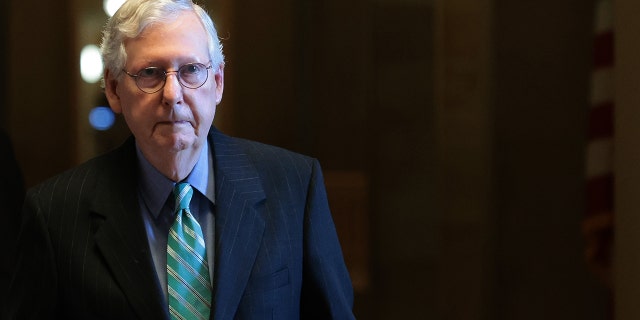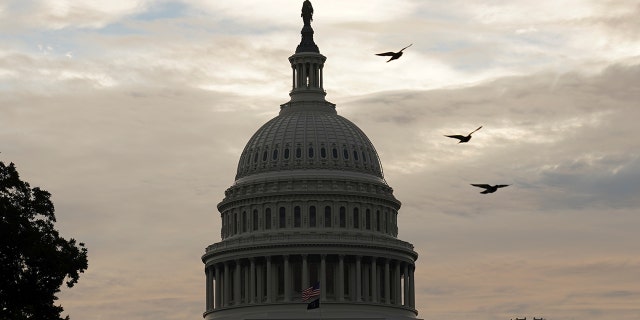Congress has several must-give packages to deliver by Christmas
Media top headlines November 29
In media news today, a ‘Good Morning America’ guest worries omicron variant could hurt Biden’s economic ‘progress,’ CNN gets roasted for a tweet about the Waukesha parade attack, and a New York Times columnist says he has a ‘high tolerance’ for inflation.
Thanksgiving is now in the rearview mirror on Capitol Hill.
It’s on to Christmas — in more ways than one.
The intense back-and-forth between moderate and progressive Democrats over passing the social spending and infrastructure bills that dominated the late summer and early fall is behind everyone. The record-breaking, overnight speech by House Minority Leader Kevin McCarthy, R-Calif., in opposition to the $1.75 trillion spending package. Even time with family and friends over the holiday. The green bean casserole. Fluffy mashed potatoes. Stuffing (or dressing, as it’s called in the south). The pumpkin and pecan pies. Another loss by the Detroit Lions.
These are but memories.
“We always have drama this time of year because we put off the big things until now or before Christmas to get them done,” said Rep. Al Green, D-Tex., on Fox. “It’ll take some compromise. But we’ll get there.”
The “must-dos” are as follows.
The Senate “must” approve the annual defense policy bill. That’s on the floor this week. Senate Majority Leader Chuck Schumer, D-N.Y., believed the Senate could complete that this week. The House approved its version of the measure weeks ago. But the defense bill doesn’t absolutely have to be done at the end of this week. It could slide, if necessary.
The one thing that Congress must do this week — or face dire consequences — is approve a Band-Aid bill to avert a government shutdown this weekend. The government is funded through 11:59:59 p.m. ET Friday.
Congress passed its first “Continuing Resolution” (or, “CR,” in Congress-ese) earlier this fall to avert a shutdown. The plan is to approve a short-term bill through the House and Senate this week. Such a stopgap bill could run until January or February. Republicans may want the plan to fund the government through March.
The upside for Democrats if they approve an interim spending bill is that the government doesn’t shutter on their watch. Democrats control the House, Senate and White House. Democrats have hoped — without much success — to contrast their style of governance to what many viewed as chaos under former President Trump. The Trump administration featured two government shutdowns. One dragged on for more than a month from late 2018 and into early 2019.
House Speaker Nancy Pelosi of Calif., and Senate Majority Leader Chuck Schumer of N.Y., talk before President Joe Biden signs the $1.2 trillion bipartisan infrastructure bill into law during a ceremony on the South Lawn of the White House in Washington, Monday, Nov. 15, 2021.
(AP Photo/Susan Walsh)
But the downside for Democrats is that CRs simply renew all of the federal spending at the old level. In other words, the first opportunity President Biden and congressional Democrats had to put their imprimatur on federal spending was Oct. 1. That was the start of fiscal year 2022. But since there was no agreement, they simply re-upped the old funding. Democrats will have to agree to an extension of old programs again this week just to avert a shutdown.
Democrats are essentially leaving their spending priorities at the table with a CR. There is an advantage in this for Republicans. The government essentially functions on a “Trump budget” the longer the GOP can string this out into the new year. That blocks Democrats from implementing their own spending bills. This is why some GOPers prefer holding off on an overall spending package until March. They may not agree to a short-term extension advocated by Democrats.
Remember, this must be accomplished by Friday night.
What a great way to start the holiday season.
Lurking somewhere in the background (as it seemingly always does) is a fight over the debt ceiling.
No Republicans in either chamber broke with their side to help Democrats approve a $480 billion increase in the debt ceiling. But just enough Senate Republicans voted yes on a procedural vote to break a filibuster to allow Democrats to walk the plank on their own.
After a football-spiking speech by Schumer during the last crisis, Senate Minority Leader Mitch McConnell, R-Ky., promised his side wouldn’t help Democrats with the debt limit this time. But just before Thanksgiving, Schumer and McConnell spoke about the issue.
When asked how the sides may unwind the debt ceiling knot this time, McConnell recently sounded more conciliatory.
Senate Minority Leader Mitch McConnell (R-KY) walks to the U.S. Senate chamber at the U.S. Capitol October 7, 2021 in Washington, DC.
(Photo by Win McNamee/Getty Images)
“We’ll figure out how to avoid default,” said McConnell. “We always do.”
McConnell and other Republicans have long said that Democrats should lift the debt ceiling on their own using a special, filibuster-exempt bill known as reconciliation. Democrats are using that type of bill to pass their own social spending package.
Granted, Republicans will do all they can to blame Democrats for excessive spending. They’ll point to the partisan $1.9 trillion coronavirus bill Democrats jammed through in March with zero assistance from the GOP. Republicans will excoriate Democrats for larding up the social spending bill with lots of unnecessary campaign promises.
Politically, this works for the GOP even if they are responsible for some of the debt. All of the COVID aid Congress approved last year cleared both houses on a bipartisan basis and was signed by President Trump. But Republicans can still condemn Democrats as the party of “tax and spend” with the social spending bill waiting in the wings.
The United States lacked a debt ceiling until 1917. The imposition of a statutory debt ceiling as a part of the Second Liberty Bond Act was supposed to give Congress some control over how much debt the U.S. incurred. But with a federal debt pushing $29 trillion, it’s evident that a legislative debt ceiling harness hasn’t worked. That in turn has converted the periodic debt ceiling seesaw into little more than a dangerous political exercise. Each side tries to score points over debt incurred by their counterparts every time the debt ceiling comes to the forefront.
Treasury Secretary Janet Yellen told Congress recently that lawmakers should aim to hike the debt ceiling by Dec. 15. But some private estimates believe the federal Treasury will remain flush with cash and be able to pay its bills beyond that — perhaps as long as February.
FILE PHOTO: Birds fly near the U.S. Capitol in Washington, U.S., October 4, 2021.
(REUTERS/Kevin Lamarque/File Photo)
It’s possible Congress could glom the government funding bill and the debt ceiling measure together. But no one is really on the same page.
There was a time not that long ago that Schumer believed the Senate would consider the social spending package during “the week of Nov. 15.”
Now they’ll be lucky if they get to it by Christmas.
So, the immediate focus is on the defense bill and avoiding a government shutdown.
For Democrats, passing the social spending bill by Christmas would be ornaments on the tree.
And at the rate things are going, those may be the only ornaments anyone in Washington sees this year.
Source: Read Full Article





